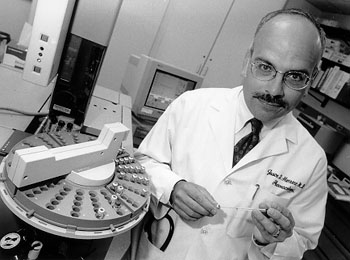Scientist tracks compounds formed when oxygen attacks

Dr. Jason Morrow is investigating isoprostanes, compounds formed following oxidant stress.
The compounds that form when oxygen turns from friend to foe are the focus of novel research that has garnered Dr. Jason D. Morrow a prestigious Burroughs Wellcome Fund Clinical Scientist Award in Translational Research.
Morrow, associate professor of Medicine and Pharmacology, and Dr. L. Jackson Roberts, professor of Pharmacology and Medicine, discovered the compounds, called isoprostanes, in 1990. Isoprostanes are produced in cells when reactive molecules called free radicals interact with membrane lipids. Excessive formation of free radicals is characteristic of oxidant stress.
"We look at the role of oxidant stress in human physiology and pathophysiology," Morrow said. "The isoprostanes are the most accurate measure to assess oxidant stress in vivo in human beings, and a number of them possess potent bioactivity and likely mediate the pathophysiological consequences of oxidant stress."
Morrow and his colleagues have focused on atherosclerosis and Alzheimer's disease.
"We have been able to implicate oxidant stress in the pathophysiology of atherosclerosis," Morrow said. "High levels of isoprostanes are present, and we know they possess mitogenic activity that is consistent with the development of atherosclerotic plaques."
In fact, of three accepted risk factors for atherosclerosis – heavy cigarette smoking, hypercholesterolemia, and hyperhomocysteinemia – all are associated with increased isoprostane formation.
In epidemiological studies, antioxidants like vitamin C and vitamin E appear to decrease atherosclerosis, but it is unknown whether they decrease the production of isoprostanes. Morrow will address this question.
"A major part of the grant is to study what pharmacological compounds in vivo will modulate, or really decrease, the formation of these molecules. We are also interested in determining how varying doses of different antioxidants affect isoprostane formation," Morrow said.
Morrow has collaborated with Dr. Thomas J. Montine, assistant professor of Pathology and Pharmacology, to study isoprostanes in Alzheimer's disease.
"We have shown that isoprostane levels in cerebrospinal fluid are significantly increased in living patients with an Alzheimer's disease diagnosis, and that the levels correlate with disease severity," Morrow said.
These findings support a theorized role for free radicals in Alzheimer's disease and have important implications for patients, Morrow said. Isoprostanes may serve as useful markers to assess and definitively diagnose the disease in living patients. Currently, Alzheimer's disease is a probable diagnosis that can only be confirmed by examining the brain after death.
"Isoprostanes may also be very useful for monitoring response to therapy, which for Alzheimer's disease is in its infancy," Morrow said. "One form of therapy is high dose vitamin E; but is it actually decreasing isoprostane levels? We don't know."
Isoprostanes are not formed only in association with disease. The body's cells produce these compounds at a fairly continuous and constant rate.
"I think their production is a consequence of free radical reactions that go on in the body all the time," Morrow said. "There are many sources of free radicals, including exogenous chemicals and endogenous enzyme systems."
And it's an unavoidable fact of life. Oxygen is constantly being breathed, and it participates in processes that produce free radicals. Should we be taking vitamin E or C or other antioxidants all the time? That's an open question, Morrow said.
"We have data that vitamin C deficiency is associated with increased oxidant stress. We now want to determine whether supplementation of vitamin C above normal levels decreases oxidant stress."
The body normally produces its own antioxidants that balance out the production of free radicals. No one really knows what throws the system out of whack and sparks disease.
Morrow's research exemplifies the kind of translational research – the path between basic research and patient care – that the Clinical Scientist Award targets.
"We've gone from the basic science observation of the existence of a group of compounds all the way up to exploring how to modulate their formation in human beings," Morrow said.
The Burroughs Wellcome Fund (BWF), an independent private foundation, established this award program to address the shrinking number of physicians involved in biomedical research. Because physician-scientists are in a position to identify and implement advances in the basic sciences, a decrease in their presence within the research enterprise threatens the critical link between the bench and the bedside. The BWF Clinical Scientist Awards intend to strengthen that link.
"It is a wonderful award," Morrow said. "It frees people at a mid-career point to really do some novel translational research."
BWF chose nine award recipients from a field of over 100 applicants. Each will receive $750,000 over the next five years, with few strings attached.
"The competition is incredibly stiff," said Dr. Eric G. Neilson, Hugh Jackson Morgan Professor and Chair of Medicine. "It is the pinnacle of achievement for a young investigator in Clinical Pharmacology to receive one of these awards."













